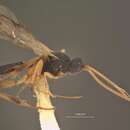Distribution
provided by Catalog of Hymenoptera in America North of Mexico
Md., Va., Iowa.
- bibliographic citation
- Catalog of Hymenoptera in America North of Mexico. 1979. Prepared cooperatively by specialists on the various groups of Hymenoptera under the direction of Karl V. Krombein and Paul D. Hurd, Jr., Smithsonian Institution, and David R. Smith and B. D. Burks, Systematic Entomology Laboratory, Insect Identification and Beneficial Insect Introduction Institute. Science and Education Administration, United States Department of Agriculture.
Comprehensive Description
provided by Smithsonian Contributions to Zoology
Orgilus intermedius
Because of its narrow and proturbant face, relatively large ocelli, and very short malar space this species is placed in the group represented by obscurator (Nees) and its close relatives, although it differs from other forms of this group in its more convex and somewhat receding temples. In the structure and sculpture of the thorax and abdomen it is suggestive of zonalis, new species, but its narrow face, short malar space, and narrower temples distinguish it immediately from that form.
FEMALE.—Length about 3.5 mm. Head not wider than thorax, in dorsal view about 0.75 as long as wide, weakly excavated behind; face prominent, a little narrower than eye height, minutely granulose or shagreened; malar space about 0.3 as long as eye height and much shorter than longest segment of maxillary palpus; anterior tentorial pits barely below level of lower eye margins; clypeus strongly convex and longer than the width of its apical truncature; cheeks weakly shagreened on lower half; temples 0.75 as wide as eyes, rounded and somewhat receding, smooth and polished; occiput carinately margined only at the sides; ocellocular line 1.5 times as long as diameter of an ocellus; antennae of holotype incomplete, 27 segments remaining, none of the flagellar segments as broad as long.
Thorax slender; notauli deeply and sharply impressed and finely foveolate; middle lobe of mesoscutum and the parts of the lateral lobes adjacent to the notauli, as well as the disc of scutellum, finely shagreened and rather mat; propodeum nearly horizontal, granulose and with some rugulae; side of pronotum largely finely granulose and dull, rugulose in the impression; mesopleuron faintly alutaceous below the narrow, foveolate, longitudinal furrow, shiny; metapleuron evenly granulose and dull. Hind coxa finely granulose and dull above and on outer side; hind femur not more than four times as long as broad; inner calcarium of hind tibia fully half as long as metatarsus; tarsal claws simple. Radial cell on wing margin hardly as long as stigma; second abscissa of radius on a line with intercubitus; stub of third abscissa of cubitus as long as second abscissa; nervulus nearly interstitial; hind wing more than five times as long as wide; lower abscissa of basella much longer than nervellus, more than half as long as mediella and also more than half as long as maximum width of hind wing.
Abdomen a little longer than thorax; first tergite nearly 1.5 times as long as wide at apex, strongly granulose and mat, the dorsal keels indistinct; second tergite about as long as broad at base, noticeably wider at apex than at base, and closely granulose like the first; second suture fine but sharply impressed; third tergite with basal half or more finely granulose, or shallowly confluently punctate; remainder of dorsum of abdomen smooth and shiny; ovipositor sheath about as long as propodeum and abdomen combined.
Black; antennae testaceous, brownish black apically, the scape brownish above; palpi pale; legs testaceous; apical half of hind femur, apical third or more of hind tibia, and more or less of the tarsi, darkened; tegulae and wing bases yellow; wings weakly infumated; second tergite brownish with narrow reddish-yellow lateral margins on basal half; basal two sternites yellow.
MALE.—In general like the female. The segments of the antennal flagellum, however, are all noticeably longer than broad, the temples are relatively a little wider, sometimes the tegulae are brownish, the hind coxae are blackish basally, and the hind femora and tibae and all the tarsi are more extensively darkened.
HOLOTYPE.—USNM 70172.
DISTRIBUTION.—Known only from the type-series, which consists of the following: The holotype female and 1 male collected at Rosslyn, Virginia (no date on labels), by H. H. Smith; 1 male from Cabin John, Maryland, 29 June 1917, R. M. Fouts; 1 male from Plummers Island, Maryland, 18 August 1912, J. R. Malloch, and 1 male from Glen Echo, Maryland, 16 June 1919, R. M. Fouts.
- bibliographic citation
- Muesebeck, Carl F. W. 1970. "The Nearctic species of Orgilus Haliday (Hymenoptera: Braconidae)." Smithsonian Contributions to Zoology. 1-104. https://doi.org/10.5479/si.00810282.30

